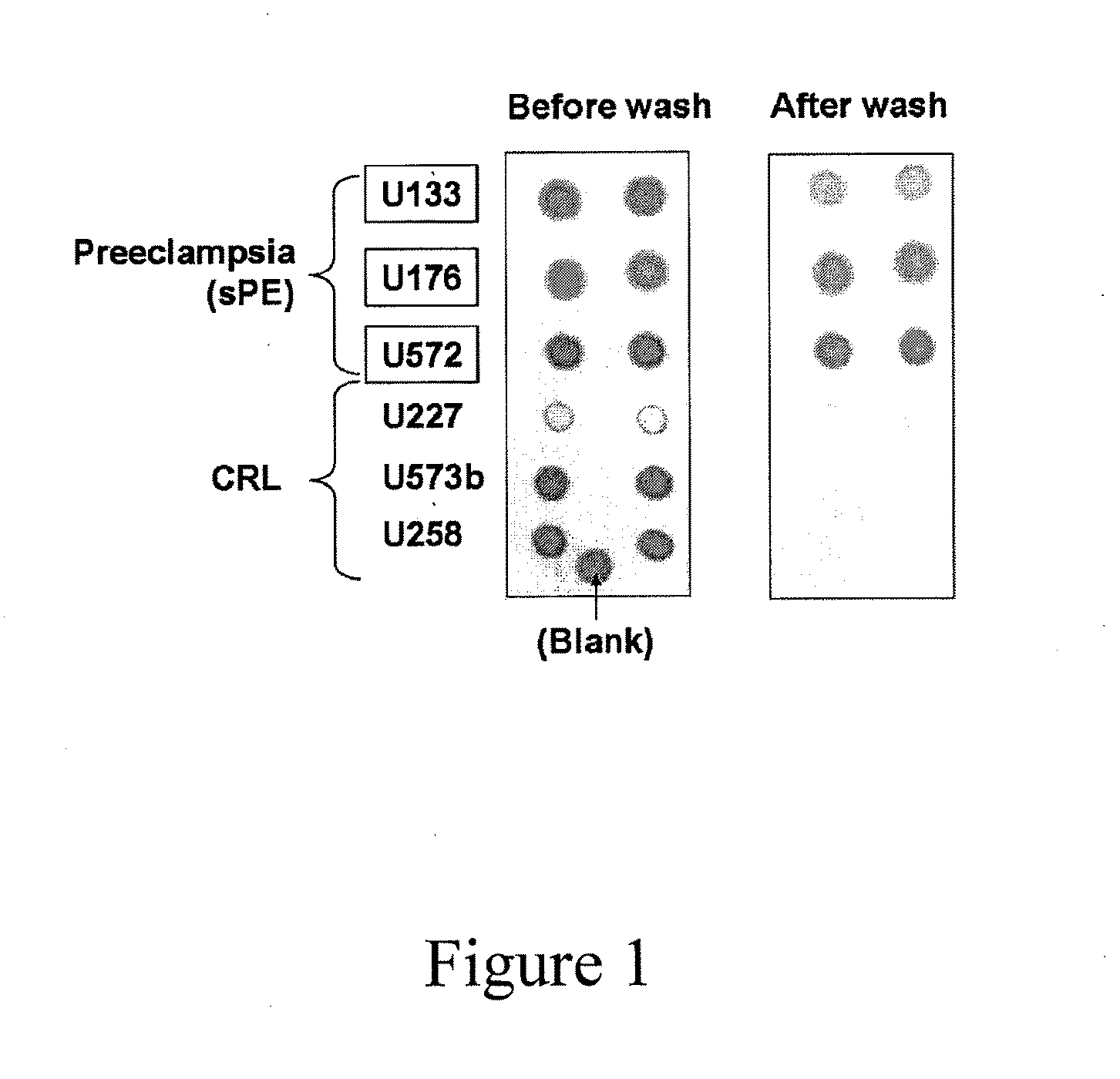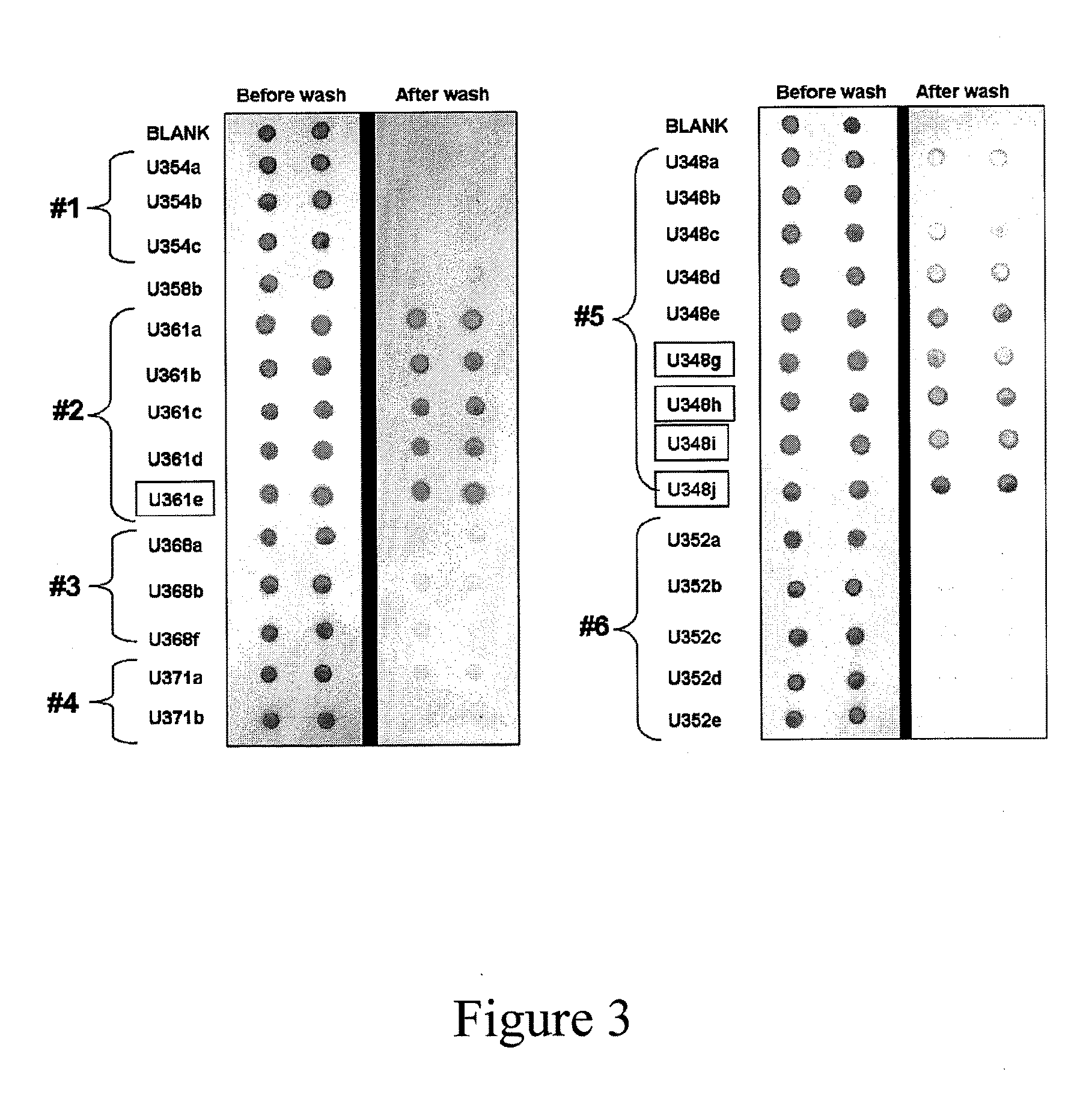Methods and kits for detecting misfolded proteins
a technology for misfolded proteins and kits, applied in the field of methods and kits for detecting misfolded proteins, can solve the problems of insufficient insight into the likelihood of the most severe symptoms developing, the method is not precise, and the risk of preeclampsia is low, so as to reduce the rate of abnormal folding and the effect of aggregation
- Summary
- Abstract
- Description
- Claims
- Application Information
AI Technical Summary
Benefits of technology
Problems solved by technology
Method used
Image
Examples
example 1
Methods
Protocol Congo Red Dot Blotting of Urine Samples (Red Dot Test):
[0244]1. Centrifuge obtained urine samples at 1500×g, 15 minutes and 4° C.
2. Measure urine protein in the spun urine using the Pierce BCA kit (Thermo Scientific Cat#23225). Urine samples may require a 12-fold dilution for protein measurement. Urine samples from women that are potentially preeclampsic have wide variations in protein concentration. Protein levels in urine also vary widely in healthy people depending on the state of hydration. For this reason it is preferred to equalize the total protein concentration. Out of over 680 urine samples obtained from women only approximately 5% (37 / 681) of urine samples measured <2 mg / mL total protein. Approximately 60% of urine samples had over 6.6 mg / mL total protein. Generally, in most of the cases there is no need to dry the samples, e.g. in the SpeedVac. The drying method was validated and it was found that sample drying does not change the Red Dot Test result. For ...
example 2
Methods
Study Design:
[0256]347 pregnant women were enrolled prospectively in the following groups: normotensive controls (CRL n=98, GA:27[7-42 weeks]); chronic hypertension (cHTN n=40, GA:32[11-41 weeks]), gestational hypertension (gHTN n=8 GA:37[26-39 weeks]), mild PE (mPE n=36, GA:36 [24-41 weeks]), severe PE (sPE n=117, GA:32[22-42 weeks]), superimposed PE (spPE n=33 GA:33[18-40 weeks]). 35 asymptomatic women were tested serially throughout gestation. A “Congo Red (CR) Dot” test was standardized with equal urine protein and objectively quantified within minutes as % Congo Red retention (CRR). CRR was evaluated for its ability to predict an indicated delivery for PE (IND) compared to protein-to-creatinine ratio (P / C) and the previously validated urine sFlt1 / PlGF ratio, as described herein and also in (U.S. Publ. No: US-2006-0183175; PCT / US2005 / 047010).
Results:
[0257]PE is characterized by increased excretion of misfolded proteins with affinity for the azo dye Congo Red (CR), also us...
example 3
Methods
Study Design:
[0259]111 urine samples from women enrolled in 3 groups: sPE (n=49, GA: 28±1 weeks), chronic hypertension (cHTN n=12, GA: 29±1 weeks) and normotensive controls (CRL n=50, GA: 28±1 weeks) were analyzed. Equal amounts of urine protein was subjected to dot blot using 3 conformation-specific antibodies recognizing prefibrillar soluble oligomers (A11, Invitrogen), ring-shaped protofibrils (Officer) or fibrils (OC). Specificity was confirmed by omitting the primary antibodies. Identity of aggregated component proteins was sought by mass spectrometry and validated by Western blot with sequence-specific antibodies.
Results
[0260]Protein conformational disorders such as Alzheimer's, light chain amyloidosis and prion diseases are propagated by amyloid fibril formation and aggregation due to defective folding of cellular proteins into aberrant 3D structures. Soluble pre-amyloid oligomers (intermediates in fibril assembly) have proteotoxic effects leading to endothelial damage...
PUM
 Login to View More
Login to View More Abstract
Description
Claims
Application Information
 Login to View More
Login to View More - R&D
- Intellectual Property
- Life Sciences
- Materials
- Tech Scout
- Unparalleled Data Quality
- Higher Quality Content
- 60% Fewer Hallucinations
Browse by: Latest US Patents, China's latest patents, Technical Efficacy Thesaurus, Application Domain, Technology Topic, Popular Technical Reports.
© 2025 PatSnap. All rights reserved.Legal|Privacy policy|Modern Slavery Act Transparency Statement|Sitemap|About US| Contact US: help@patsnap.com



